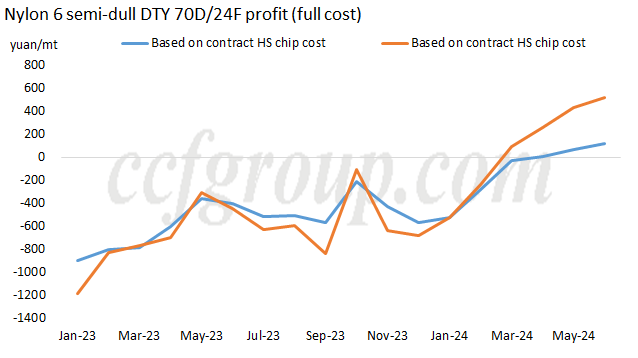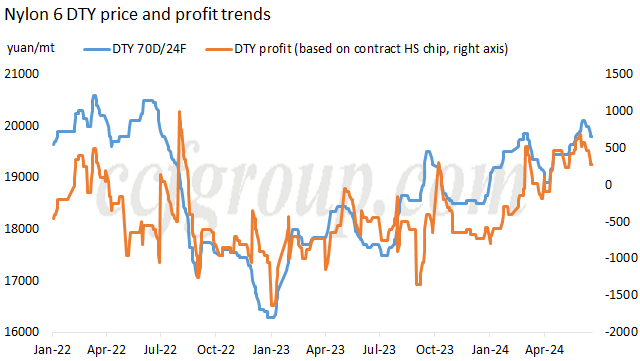NFY processing fee reaches its peak
1. NFY processing fee has reached a peak and has shown signs of weakening.

Since the beginning of this year, nylon 6 textile filament yarn (NFY) processing fees have been continuously improving. From a full-cost perspective, starting from April, even the most conventional and least profitable products have generally turned losses into profits, with profits steadily increasing. The average monthly profit in June has reached the highest point so far this year. The improvement in NFY profits is attributed to the strengthening of supply and demand as well as the predictability of costs, as detailed in the insight "Nylon filament profit improvement temporary or trending."

Although the monthly profits are satisfactory, this month, filament factory pricing has shown signs of weakness. When CPL contract price rose to 14,120yuan/mt at the beginning of the month, some manufacturers followed the price increase promptly. However, the actual traded prices still followed the CPL pricing of 13,985yuan/mt or slightly lower at 13,700yuan/mt, showing a somewhat weak response to the price increase. By the mid to late June, with CPL spot price falling to 13,680yuan/mt, although the expected contract settlement was between 13,800-13,900yuan/mt, filament factories swiftly lowered their quotes based on CPL pricing of 13,680yuan/mt to stimulate orders. Considering the contract raw materials as cost references, NFY processing fees have started to decline.
2. With weakening demand and poor expectations, processing fee is expected a further compression.
The weakness in filament factory pricing is mainly due to signs of weakening demand. Since mid-May, there has been a gradual reduction in orders from sun protection-related fabric factories, followed by declines in orders from warp knitting and circular knitting factories. In addition, the surge of nylon 6 semi-dull HS chips has accelerated the shift of feather yarn factories to use polyester instead of expensive nylon. Weaving and knitting factories have seen a reduction in their own orders, leading to a gradual decline in demand for NFY.
Furthermore, the high prices of benzene, coupled with no other positive expectations in nylon industry itself, have increased awareness of risk for a high-level fall in benzene. Considering current good profit and concerns about the weakening demand in the off season, it has become the mainstream operating strategy for filament factories to offer appropriate discounts and try to secure orders as much as possible.
3. Fundamentals are still good, so the downward space for processing fees will be limited.
However, despite a high operating rate of 94.3%, the rate of NFY inventory increase is not fast. Moreover, the previous inventory base was very low, leading to the current industry inventory being only slightly above 10 days, still at a relatively low level in history. This also means that NFY factories do not face significant inventory pressure in short, and offering discounts for sales is mainly to guard against the risk of possible losses in the future when a downturn in benzene prices happens.
Moreover, in the first half of 2024, NFY processing fees have been continuously rising, with a relatively substantial profit margin. Offering some profit margin for risk aversion will not lead to market price wars. Additionally, given the relatively benign industry fundamentals at present, rapidly reducing processing fees may cause downstream anxiety and hinder the stable shipment of filament factories. Therefore, it is expected that NFY processing fees will be moderately compressed during the seasonally weaker demand period, but the compression space is limited.
- Top keywords
- Cotton Price
- Cotton Futures Price
- Cotton Futures
- CZCE
- PTA Futures Price
- Chemical Fiber
- Polyester Prices
- Wool price
- PTA Futures
- Shengze Silk
- China
- Yarn Price
- price
- China Textile City
- Fibre Price
- Benzene Price
- Cotton
- Index
- Cotton Index
- PTA
- fabric price
- NYMEX
- Top 10
- textile industry
- Spot Cotton
- Cotton Yarn
- Polyester Price
- Futures
- PTA Price
- cotton yarn price

